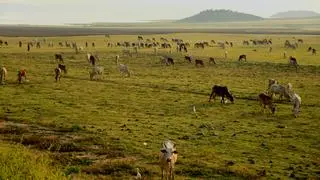
With India’s livestock population standing at 536.76 million, as per the Department of Animal Husbandry and Dairying (DAHD), integrating smart technologies has become imperative for improved productivity
| Photo Credit:
C_V_SUBRAHMANYAM
For decades, India’s livestock sector has been the backbone of rural livelihoods, contributing significantly to the agricultural economy. Traditionally centred on milk and meat production, the industry is now at the forefront of a technological transformation, integrating cutting-edge innovations to enhance productivity, sustainability, and traceability.
According to a 2024 report by the Ministry of Fisheries, Animal Husbandry and Dairying, the livestock sector’s share of agriculture and allied sector Gross Value Added (GVA) has risen from 24.38 per cent in 2014-15 to 30.23 per cent in 2022-23, now accounting for 5.50 per cent of India’s total GVA. However, beyond these economic contributions, the sector is undergoing a profound shift driven by agri-tech advancements, bioeconomy initiatives, and the growing need for sustainable food systems.
As India navigates the challenge of feeding a rising population while mitigating environmental impacts, innovations such as precision livestock farming, biotechnology, and blockchain-driven traceability are redefining the industry. This transformation is not only improving farm efficiency and animal health but also positioning India’s livestock sector as a key player in the broader bioeconomy.
The evolution of livestock in India’s agtech space
The livestock sector has undergone significant technological advancements, driven by the need for efficiency, sustainability, and resilience. With India’s livestock population standing at 536.76 million, as per the Department of Animal Husbandry and Dairying (DAHD), integrating smart technologies has become imperative for improved productivity.
At the forefront of this transformation is Precision Livestock Farming (PLF), which leverages Internet of Things (IoT) sensors, artificial intelligence (AI), and big data analytics to monitor animal health, optimise feeding, and predict diseases. These advancements help farmers make real-time, data-driven decisions, improving both productivity and cost-efficiency.
In the dairy sector, smart farming solutions such as automated milking systems and real-time health tracking devices are improving milk yield, reducing labour costs, and ensuring better animal welfare. Meanwhile, blockchain technology is revolutionising the livestock supply chain, enabling end-to-end transparency, fraud prevention, and efficient recall mechanisms, ultimately bolstering consumer trust.
This wave of innovation is not just confined to India. Globally, agri-tech advancements such as cultured meat, plant-based protein, and carbon-neutral livestock farming are redefining the industry. As India continues to adopt and adapt global best practices, the livestock sector is poised to play a crucial role in shaping the future of sustainable agriculture.
Contribution to the bioeconomy
India’s bioeconomy is expanding rapidly, with the livestock sector playing a crucial role in its growth. Defined by the sustainable use of biological resources for economic and environmental benefits, the bioeconomy has gained significant traction. According to a government report, India’s bioeconomy is valued at over $165 billion in 2024, contributing more than 4.2 per cent to the nation’s GDP. This growth highlights the increasing influence of biotechnological advancements in agriculture and animal husbandry.
Innovations in genetic breeding are enhancing milk and meat yields, improving disease resistance, and promoting overall livestock health. At the same time, researchers are developing sustainable feed alternatives, such as insect-based protein and lab-grown fodder, to reduce reliance on traditional feed sources and minimise environmental impact. Additionally, waste-to-energy initiatives are converting livestock waste into biofuels, significantly cutting methane emissions while creating new revenue streams for farmers.
Government initiatives and industry collaborations
Recognising the potential of the livestock sector in driving agri-tech innovation and strengthening the bioeconomy, the Indian government has launched several key initiatives. The National Biotechnology Development Strategy aims to enhance efficiency and productivity in agriculture and allied sectors by promoting biotech products and technologies. Additionally, India’s agri-tech ecosystem has seen a surge in investor interest, with investments increasing from $370 million in 2019 to $1.25 billion in 2021. This influx of capital is driving the development of cutting-edge solutions in livestock management and agriculture.
Industry collaborations have also played a crucial role in fostering innovation. Policy changes allowing the import of only non-GM maize have ensured affordable livestock feed, while a reduced import duty of 5 per cent on aqua feed has benefited aquaculture farmers. Additionally, efforts to explore alternative ingredients like sorghum as a substitute for corn are gaining traction, ensuring more sustainable and cost-effective feed solutions. Moreover, initiatives to educate young professionals on sustainable livestock practices are equipping the next generation with the necessary knowledge to enhance the industry’s long-term growth.
Challenges and the road ahead
Despite promising advancements, the integration of technology in the livestock sector faces several challenges. Small and marginal farmers, who form a significant portion of the agricultural community, often struggle to access and afford advanced technologies. Additionally, comprehensive training programs are needed to equip farmers with the necessary skills to effectively use emerging technologies. Infrastructure constraints, particularly in rural areas, also pose a challenge, as reliable internet connectivity and access to modern facilities are essential for successful implementation.
Addressing these challenges requires a collaborative approach involving the government, private sector, and research institutions. Inclusive policies, financial support, and infrastructural development will be key to ensuring widespread adoption of innovative technologies in livestock farming.
Conclusion
The evolution of the livestock industry beyond traditional meat and milk production into a hub of agri-tech innovation is transforming India’s agricultural landscape. By leveraging biotechnology, AI, and precision farming tools, the sector is enhancing productivity, ensuring sustainability, and significantly contributing to the bioeconomy. With continued investment, supportive policies, and a focus on inclusivity, India’s livestock industry is poised to lead the way in agricultural innovation, benefiting millions of farmers and strengthening the economy at large.
The author is chairman at CLFMA (The Compound Feed Manufacturers Association)
More Like This


Published on April 5, 2025




